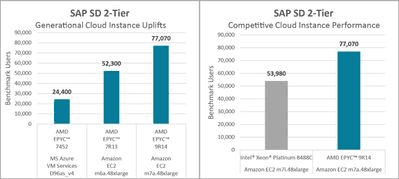SAP Sales and Distribution (SAP SD)
4th Generation AMD EPYC processors are revolutionizing data center performance, power efficiency, and total cost of ownership through continuous innovation. This dual focus on performance and efficiency demonstrates AMD’s commitment to offering companies cutting-edge solutions for their data Centre needs.
At the moment, the extensive AMD EPYC ecosystem includes more than 800 different cloud instances and more than 250 different server designs. In more than 300 benchmarks, including business applications, technical computing data management, data analytics, digital services, media and entertainment, and infrastructure solutions, AMD EPYC processors have achieved performance records.
One of the most important logistics modules in SAP ERP (Enterprise Resource Planning) software is SAP Sales and Distribution (SAP SD). This module is essential to the management and archiving of vital business data among four main components:
Organisation Structure
By defining different units, divisions, and departments involved in the sales and distribution processes, SAP SD controls the organizational setup within the software.
Master Data
SAP SD stores material (product specs, inventory levels, and pricing) and customer (customer profiles, contact information, and transaction history) master data.
Business Processes
SAP SD manages all aspects of end-to-end , including order fulfilment, pricing, shipping, invoicing, and receiving payments. It guarantees the smooth execution and coordination of tasks linked to sales.
Reporting
With the help of SAP SD’s extensive reporting features, users can create intelligent analyses and reports using sales and distribution data. These reports offer insightful information on revenue generation, inventory management, customer trends, and sales performance.
All things considered, SAP SD is essential for improving productivity, simplifying sales and distribution processes, and facilitating well-informed decision-making in businesses using SAP ERP software.
The SAP-SD 2-Tier benchmark measures database performance in SAP Application Performance Standard units (SAPS) to assess hardware performance. Within the SAP environment, SAPS is a hardware-independent unit that measures system performance. The Sales and Distribution (SD) benchmark is the source of SAPS, which indicate how well a system can manage SAP workloads.
Vendors use their standard methodology to assess the system’s ability to support SD users during SAP benchmark testing. Every benchmark module has a weight that transforms users into a Normalised SD (NSD) number. NSD is used to calculate SAPS. SAP customers can size their SAP systems and plan their infrastructure footprint with the aid of SAPS results from the SAP SD benchmark. Customers can use this benchmark to compare platforms, plan for future growth, and perform Proof-of-Concepts (POCs) in order to choose the best hardware configuration for their SAP solution.
Regarding Bare Metal
Because SAP SD workloads are compute-intensive, 4th Gen AMD EPYC processors (9004 series) are the best option for bare metal server deployment of SAP applications. In comparison to previous-generation AMD EPYC processors, these processors maximise performance by utilising notable improvements in Instructions per Cycle (IPC), faster memory access, larger L3 cache sizes, and higher core density.
The performance gains achieved with “top of stack” processor SKUs over the course of the four generations of AMD EPYC general-purpose processors are shown in Figure 1. It also emphasises how consistently better 2nd generation AMD EPYC processors and subsequent generations are than equivalent generations of Intel Xeon processors. It is noteworthy that 5th generation Intel Xeon processors perform 53% worse than 4th generation AMD EPYC processors.

Within the Cloud
Do you want to use SAP in the cloud? Additionally, AMD EPYC processors provide extensive support in this area. Significant performance improvements across 2nd, 3rd, and 4th Gen AMD EPYC processors on Microsoft Azure and Amazon EC2 cloud instances are shown on the left side of Figure 2.On the right side of Figure 2, an Amazon EC2 m7a.48xlarge instance with 4th Gen AMD EPYC processors outperforms one with Intel Xeon Platinum 8488C processors.

SAP-SD Performance Analysis (Curiosity Analysis) Compared to SPEC CPU 2017
Many people make an effort to explain how the SPEC CPU 2017 benchmark accurately reflects enterprise applications found in the real world. Because of the extensive stress that its performance measurements place on a system’s processor, memory subsystem, and compiler, the SPEC CPU 2017 benchmark enjoys considerable industry prominence. Users can effectively compare the performance of different systems thanks to these measurements. While SPECspeed metrics track task completion time, SPECrate metrics track work completed per unit of time.
SAP SD 2 Tier
Of these metrics, Figure 3 shows that SPECrate 2017 Integer has a strong correlation with the SAP-SD 2-Tier Benchmark Users metric. Because it enables the derivation of trustworthy estimates for SAP-SD 2-Tier Benchmark Users based on the SPECrate 2017 Integer metric results published for each EPYC SKU, this correlation is especially valuable for SAP SD 2-Tier sizing.

In summary
The SAP SD benchmark results highlight AMD EPYC processors’ exceptional performance in the cloud and on bare metal. Cutting-edge technologies are supported by AMD EPYC processors from the 4th generation, such as “Zen 4” cores based on 5nm process technology, up to 12 DDR5 memory channels supporting up to 4800GHz in memory speed support, and up to 128 (1P) or 160 (2P) PCIe Gen5 lanes that offer twice the PCIe Gen4 transfer rate.
While AMD Infinity Guard technology improves data security while in use, the 3rd generation Infinity Fabric doubles the data transfer rate of the 2nd generation Infinity Fabric.[5] The lineup of 4th Gen AMD EPYC processors is further expanded by the AMD EPYC 97×4 and AMD EPYC 9004 processors with AMD 3D V-CacheTM technology, which are optimised models for memory-bound workloads and cloud infrastructure, respectively.

